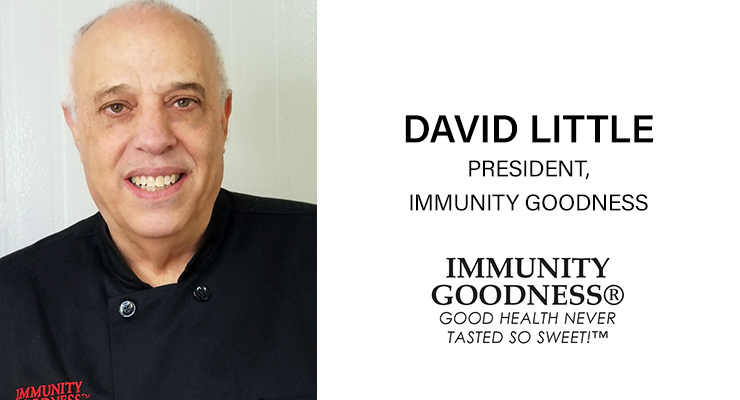Health E-Insights
‘Chocopreneur’ David Little Wields Chocolate to Serve Up Health Supplements
President of Immunity Goodness offers formulation insight on functional edibles.

By: Sheldon Baker

A CPA turned Chocopreneur and formulator, David Little is president of New Jersey-based Immunity Goodness. He and his staff produce innovative edible supplements, as well as non-supplemental edible consumer products. For over 30 years, Little’s team of scientists, chefs, flavor technologists, and compounding pharmacists have researched a variety of carrier bases before settling on chocolate as a consumption and infusion vehicle. Chocolate was selected because of its overall taste appeal and bioavailability. His team works with various partners to ensure consistency across all brand lines. Immunity Goodness operates in an FDA registered, cGMP facility and is a member of the Specialty Food Association. Little has developed and distributed products for many top consumer brands including Starbucks, Kraft/Gevalia, Keurig, Christian Dior, and Diageo. He is a graduate of Emory University in Atlanta, GA, and holds an MBA from Tulane University in New Orleans.
Health E-Insights (HEI): Talk a little about the company’s history.
Little: Immunity Goodness was launched in 1992, specializing in chocolate and related food manufacturing, primarily for B2B. We have partnered with many leading brands including Revlon and UPS. A few years ago, we were hired to manufacture confectionery and chocolate products for the CBD industry. This resulted in setting up a dedicated lab area for compliance with FDA and state rules, resulting in becoming FDA registered and a certified cGMP facility, thus allowing us to work with a larger group of clients in the supplement ingredient and retail industries.
Using our experience, combined with the arrival of COVID-19, our chocolate line of edible products was expanded, infusing products with immunity-boosting formulas. Continuing forward, the company added a line of other edible supplements designed to aid sleep, help increase energy, enhance eye health, as well as offer a children’s 100% RDA multivitamin line.
We also started discussions with various supplement ingredient suppliers that were interested in offering an alternative functional food delivery system for their products. Immunity Goodness has been hired to create and manufacture products that were shown to their clients as an idea for future marketable products. We then have been able to work with the supplier to create direct-to-consumer products under their brand. More recently, our customers have asked for additional confectionery delivery systems, so we have developed hard candy concepts.
HEI: I bet you have fun with your title, Head Chocopreneur?
Little: It was given to me some years back by a customer who felt it offered an obvious meaning of an entrepreneur who works in chocolate. I found it quite apropos. As we expanded into infusing different confectionery products, I was recently nick named the “Willy Wonka of Supplements.”
HEI: How long have you been infusing supplements with chocolate?
Little: About a decade. Each supplement requires a different approach based on a variety of factors. We have infused quite a wide variety of supplements, ranging from ashwagandha to wasabi and dozens in between.
Some of the more unique ones include multiple Ayurvedic ingredients, omega-3s, CBD, and cricket powder. Recently, our clients have asked us to work with ingredients like magnesium, bacopa, collagen, apricot seeds, and monk fruit to develop products highlighting the benefits of these supplements. Many times, we approach the process from a different angle, formulating multiple ingredients creating a desired supplement unique to a specific malady. I am particularly proud of our glutathione precursor for people with immune deficiency.
Our Sweet Optics Chocolates is based on the National Eye Institute’s AREDS 1 and 2 recommended ingredients along with a group of vitamins and nutrients that assist general eye health. The Age-Related Eye Disease Studies (AREDS) are major clinical trials sponsored by the National Eye Institute designed to learn more about the natural history and risk factors of age-related macular degeneration and cataract and to evaluate the effect of vitamins on the progression of these eye diseases. Previously available in over the counter drops, we now offer this formulation in a functional chocolate.
HEI: Is it better to use milk or dark chocolate with supplement ingredients?
Little: Usually dark chocolate. With its higher cocoa content, it better masks any harsh ingredient flavors. Additionally, the healthier perception of dark, with lower calories and sugar, is consistent with industry objectives. Sometimes though, supplements go better with milk chocolate, based on the final desired flavor.
In certain cases, we have to block the harsh taste or even over-flavor the product. It is on a case by case basis because specific end flavors go better with dark vs. milk, and salted caramel pairs well with milk chocolate. Dozens of flavors and natural blockers are tested and combined to achieve our desired goal, and that is always a great tasting product. The best supplements are those with a lower required dosage, in milligrams instead of grams per serving. In most cases, there are always alternatives like taking two pieces instead of one.
HEI: Does chocolate offer more health advantages than gummies?
Little: Chocolate already includes a variety of ingredients that are beneficial, and the fat in chocolate helps aid bioavailability, unlike the high sugar content in gummies. Chocolate is especially rich in flavanols, like epicatechin and catechin, as well as anthocyanins and phenolic acids. All of these compounds help protect your cells from inflammation, improve your brain function, and boost your immune and cardiovascular health. Dark chocolate can also give you cardiovascular support.
There are also a variety of chocolates available beyond just milk and dark regular chocolate including low-fat chocolate, sugar-free chocolate with various natural or alcohol sugars, and preflavored chocolate. I have to note, what is commonly referred to as white chocolate is not considered a chocolate as it lacks cocoa content. Chocolate, due to its fluid nature, can be shaped and designed in a variety of formats such as balls, bars, lozenges, powders, and syrups. It also can be infused with nuts, crunchies, fruits, and other food pieces.
Lastly, chocolate has a gourmet cache to it. Have you ever been offered a plate of gummies after a nice dinner? Our new hard candy confectionery products bring a whole new set of challenges and advantages to them and can compete advantageously with gummies by offering more attractive delivery, visuals, and packaging options.
HEI: Will cannabis be the next additive now that it is approved recreationally in the State of New Jersey?
Little: Edibles, including chocolate, are presently being manufactured with various cannabinoids, like CBD and CBN for sleep. Though not yet available in New Jersey, or many other recreationally approved marijuana states, chocolate and cannabis combinations with THC already exist. Some of these manufacturers are combining CBD and THC 1:1 and other ratios. I do see the future of various cannabinoids and THC being mixed to obtain desired results and to increase product differentiation. Though, right now as most know, the FDA does not allow such products to be legally sold and shipped across state lines.
HEI: You also make specialty chocolate for corporate clients. For example, you could put Area Code 420 or the Nutraceuticals World logo on chocolates?
Little: We do that all the time for clients, it just depends which product format is used. A large part of our business supports the wine and spirits manufacturers, as we make a Chocolate SideCar that sits on a drink glass like a garnishment. We use European techniques which allow us to imprint chocolate with custom logos and colors, then we can flavor it as needed.
Other products that are capable of customization include candy bars, smaller pieces, balls, and various other items. All of our supplements are individually identified by the brand/product name imprinted on each piece using this technique. Interestingly, we find the B2B and CPG marketing and the supplement industry interacting. We just designed a supplement that accompanies wine that adds to the enjoyment and relaxation derived from the consumption of both the chocolate and the drink—perfect for hotel suite promotions. A large client has us making an infused edible that supports their marketing message. Lastly, we developed supplement products for NJ Pride Week.
HEI: Can Immunity Goodness also design product packaging for customer products you manufacture?
Little: Yes. First, we work on the panels and disclosure information on the package. Simultaneously determining which package type might work best, individual pouches, wrapped bar, metal tin, bag, box, and whatever our clients can think of. Usually, we start any project by formulating the serving size, dosage, and other desired goals, and then go backward to design the package look, layout, or point-of-purchase. Our team of scientists, pharmacists, and health professionals all contribute during the product development phase.
HEI: What are some of the biggest lessons you have learned over the years about making chocolate? Any secrets to making really good chocolate or do I have to go to Switzerland or France for that?
Little: I would consider our Belgian chocolate base as a comparable quality to chocolate from France or Switzerland. Generally, European chocolate is better than U.S. chocolate as it is made differently and normally contains much less sugar. Chocolate can be temperamental, as it has to go through multiple temperature cycles to crystallize correctly, allowing it to have a proper appearance, reflection, and snap.
But with supplements, it is more about learning what infuses best and how it will react with the chocolate. If you start with a quality chocolate, like ours, it works better. A lot of trial and error is needed, especially with infusing and flavoring. Fortunately, we have a group of consultant chefs and flavor technologists in Europe and the U.S. that help us through the process.
HEI: As president, what keeps you up at night?
Little: Right now, it is definitely the challenging business environment, which is not unique to us. Also, inflation, product shortages, and logistics are top of mind in today’s manufacturing business. As a wild example, due to the conflict in Ukraine, sunflower lecithin, which is an alternative to soy lecithin in certain specialty chocolates is in short supply.
We get requests to do all types of confectioneries for our clients and each project is different. Usually, I just sleep on it and sometimes I am lucky to get an epiphany in the middle of the night; and I run to my computer at 3 a.m., start reading my notes, and rethinking the process to make sure I get everything 100% correct.
Sheldon Baker is CEO of the Baker Dillon Group LLC and has created numerous nutraceutical brand marketing communications and public relations campaigns for many well-known supplement and food industry companies. For interview consideration or brand marketing consulting, reach out to him at sbaker@bakerdillon.com.


